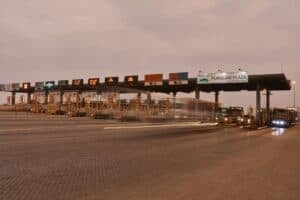If you'd walked down Dublin's O'Connell Street in Ireland this week, you might have noticed a more joyous lilt in the voice of the locals

If you’d walked down Dublin’s O’Connell Street in Ireland this week, you might have noticed an extra spring in the step – a more joyous lilt in the voice and extra joie de vivre – among the locals.
Tuesday – 6 December – after all, marked the centenary of the day the Republic of Ireland (also known as the Irish Free State, with the emphasis on “Free”) won its independence from Britain after centuries of oppression, heartbreak and vicious insurrection.
Perhaps the greatest rejoicing, outside of the multitude of pubs in this beer and whiskey-loving capital city, would have been on the section of the road between the O’Connell Bridge over the River Liffey and Parnell Street. This stretch, just over a kilometre in length, features many historic Irish republican sites including the General Post Office and Charles Stewart Parnell Monument.
Parnell, despite being a wealthy Protestant landowner in a country overwhelmingly populated by impoverished and disenfranchised Catholics, was a champion of Irish self-government 150 years ago. Upon his monument stand the words: “No man has a right to fix the boundary to the march of a nation. No man has a right to say to his country, thus far shalt thou go and no further.”
The post office, known to the Irish simply as the “GPO”, is probably (along with Kilmainham Gaol) the most famous building in Ireland as the site of the hopeless stand the Irish republican movement made against England during the 1916 Easter Rising.

According to author and former member of the Provisional IRA, Sean O’Callaghan: “At least 450 people were killed and 2 500 injured during the rising … 116 of the dead were soldiers, 22 of them Irish, plus 16 armed and unarmed policemen, all Irish.
“Sixty-four Volunteers, out of a total of just over 1 500 who played some role in the Rising, were killed. The results are clear: 205 combatants died, alongside 245 wholly innocent civilians. The dead were mostly Irish, mostly civilians, mostly Dublin’s poor, killed for a cause they hardly understood or supported.”
Burned and shattered by cannon fire just over a century ago, this week the GPO stood whole and regal… adorned with Christmas lights.

The events of 1916 are indelibly printed on the souls of the Irish, much more so than those of the Irish War of Independence fought from 1919-1921.
ALSO READ: Blackpool Illuminations not going anywhere, despite soaring electricity bills
Kilmainham’s notoriety stems mainly from the deaths of 14 men who were executed by firing squad in the stonebreakers’ yard following the rising. Seven of the men – Padraig Pearse (the commander-in-chief of the rebel army), Sean MacDermott, Tom MacDonagh, Eamon Kent, Joe Plunkett, Tom Clarke and my ancestor James Connolly – were signatories of the Proclamation of the Irish Republic.
The proclamation was read by Pearse on 24 April 1916, Easter Monday, after groups of the Irish Volunteers (the armed wing of the Irish Republican Brotherhood, later the Irish Republican Army or IRA) and the Irish Citizen Army seized the General Post Office and other buildings in Dublin.
Connolly (in Gaelic, Séamus O’Conghaile) was the last rebel leader to die. He had been badly wounded in the legs in the fighting and his wounds turned gangrenous but was nevertheless transported by ambulance from hospital to Kilmainham, tied to a chair and shot in the same courtyard as Pearse.
The 14 were buried in an unmarked mass grave at the sombre Arbour Hill military cemetery and their bodies covered with quicklime. The site was saved from obscurity with the later erection of a dual-language (English and Gaelic) memorial wall and has become a place of pilgrimage for Irish republicans.

Far from dousing the flames of rebellion, outrage at the English reaction generated popular support for Irish independence. Sinn Fein – the “political wing” of the Irish Republican Army (IRA) – won 91% of seats outside the six predominantly Protestant northern counties in the 1918 general election.
Sinn Fein refused to sit in the British seat of government at Westminster but set up its own parliament, the first Dáil Éireann, in January 1919,
The Dáil reaffirmed the 1916 proclamation of independence (read out by Pearse on the steps of the GPO) and issued a message to the world stating there was an “existing state of war between Ireland and England”.
A nasty guerrilla war erupted between the IRA and British forces, mainly because the IRA’s director of intelligence, Michael Collins, said conventional warfare – as touted by Dáil president Eamon de Valera – had proved disastrous in 1916 and would continue to do so.
It was the first of many serious disagreements between the two men and the enmity ended only when Collins was killed in an ambush in 1922. De Valera became president of the republic.
Dublin is wonderful, one of the economic powerhouses of Europe but, unlike Brussels, a fun place to visit. It is one of the most desirable places in the world to live in terms of quality of life; peaceful, with the troubles of the north having passed it by.
Scratch the surface, though, and the premise of the 1916 proclamation gleams bright: a united, undivided Ireland.

As the Wolfe Tones sing:
We’re one the one road…
North and South, comrades all
Dublin, Belfast, Cork and Donegal
We’re on the one road
Swinging along
Singing a soldier’s song
READ NEXT: Affordable ways to get to your next summer vacation






